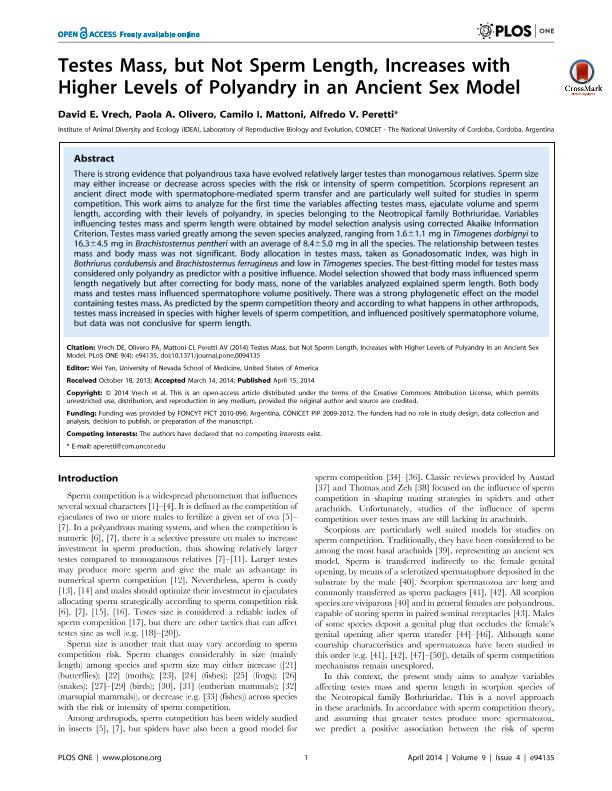Mostrar el registro sencillo del ítem
dc.contributor.author
Vrech, David Eduardo

dc.contributor.author
Olivero, Paola Andrea

dc.contributor.author
Mattoni, Camilo Ivan

dc.contributor.author
Peretti, Alfredo Vicente

dc.date.available
2018-01-04T20:48:10Z
dc.date.issued
2014-04
dc.identifier.citation
Peretti, Alfredo Vicente; Mattoni, Camilo Ivan; Olivero, Paola Andrea; Vrech, David Eduardo; Testes Mass, but Not Sperm Length, Increases with Higher Levels of Polyandry in an Ancient Sex Model; Public Library of Science; Plos One; 9; 4; 4-2014; 1-10; e94135
dc.identifier.issn
1932-6203
dc.identifier.uri
http://hdl.handle.net/11336/32364
dc.description.abstract
There is strong evidence that polyandrous taxa have evolved relatively larger testes than monogamous relatives. Sperm size may either increase or decrease across species with the risk or intensity of sperm competition. Scorpions represent an ancient direct mode with spermatophore-mediated sperm transfer and are particularly well suited for studies in sperm competition. This work aims to analyze for the first time the variables affecting testes mass, ejaculate volume and sperm length, according with their levels of polyandry, in species belonging to the Neotropical family Bothriuridae. Variables influencing testes mass and sperm length were obtained by model selection analysis using corrected Akaike Information Criterion. Testes mass varied greatly among the seven species analyzed, ranging from 1.6±1.1 mg in Timogenes dorbignyi to 16.3±4.5 mg in Brachistosternus pentheri with an average of 8.4±5.0 mg in all the species. The relationship between testes mass and body mass was not significant. Body allocation in testes mass, taken as Gonadosomatic Index, was high in Bothriurus cordubensis and Brachistosternus ferrugineus and low in Timogenes species. The best-fitting model for testes mass considered only polyandry as predictor with a positive influence. Model selection showed that body mass influenced sperm length negatively but after correcting for body mass, none of the variables analyzed explained sperm length. Both body mass and testes mass influenced spermatophore volume positively. There was a strong phylogenetic effect on the model containing testes mass. As predicted by the sperm competition theory and according to what happens in other arthropods, testes mass increased in species with higher levels of sperm competition, and influenced positively spermatophore volume, but data was not conclusive for sperm length.
dc.format
application/pdf
dc.language.iso
eng
dc.publisher
Public Library of Science

dc.rights
info:eu-repo/semantics/openAccess
dc.rights.uri
https://creativecommons.org/licenses/by-nc-sa/2.5/ar/
dc.subject
Polyandry
dc.subject
Sperm Competition
dc.subject
Botrhiuridae
dc.subject
Scorpions
dc.subject.classification
Otras Ciencias Biológicas

dc.subject.classification
Ciencias Biológicas

dc.subject.classification
CIENCIAS NATURALES Y EXACTAS

dc.title
Testes Mass, but Not Sperm Length, Increases with Higher Levels of Polyandry in an Ancient Sex Model
dc.type
info:eu-repo/semantics/article
dc.type
info:ar-repo/semantics/artículo
dc.type
info:eu-repo/semantics/publishedVersion
dc.date.updated
2018-01-03T20:58:12Z
dc.journal.volume
9
dc.journal.number
4
dc.journal.pagination
1-10; e94135
dc.journal.pais
Estados Unidos

dc.journal.ciudad
San Francisco
dc.description.fil
Fil: Vrech, David Eduardo. Consejo Nacional de Investigaciones Científicas y Técnicas. Centro Científico Tecnológico Conicet - Córdoba. Instituto de Diversidad y Ecología Animal. Universidad Nacional de Córdoba. Facultad de Ciencias Exactas Físicas y Naturales. Instituto de Diversidad y Ecología Animal; Argentina
dc.description.fil
Fil: Olivero, Paola Andrea. Consejo Nacional de Investigaciones Científicas y Técnicas. Centro Científico Tecnológico Conicet - Córdoba. Instituto de Diversidad y Ecología Animal. Universidad Nacional de Córdoba. Facultad de Ciencias Exactas Físicas y Naturales. Instituto de Diversidad y Ecología Animal; Argentina
dc.description.fil
Fil: Mattoni, Camilo Ivan. Consejo Nacional de Investigaciones Científicas y Técnicas. Centro Científico Tecnológico Conicet - Córdoba. Instituto de Diversidad y Ecología Animal. Universidad Nacional de Córdoba. Facultad de Ciencias Exactas Físicas y Naturales. Instituto de Diversidad y Ecología Animal; Argentina
dc.description.fil
Fil: Peretti, Alfredo Vicente. Consejo Nacional de Investigaciones Científicas y Técnicas. Centro Científico Tecnológico Conicet - Córdoba. Instituto de Diversidad y Ecología Animal. Universidad Nacional de Córdoba. Facultad de Ciencias Exactas Físicas y Naturales. Instituto de Diversidad y Ecología Animal; Argentina
dc.journal.title
Plos One

dc.relation.alternativeid
info:eu-repo/semantics/altIdentifier/doi/http://dx.doi.org/10.1371/journal.pone.0094135
dc.relation.alternativeid
info:eu-repo/semantics/altIdentifier/url/http://journals.plos.org/plosone/article?id=10.1371/journal.pone.0094135
Archivos asociados
